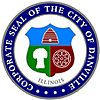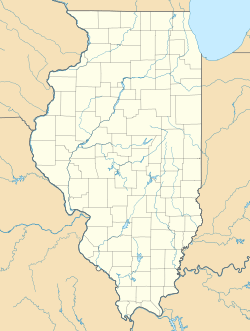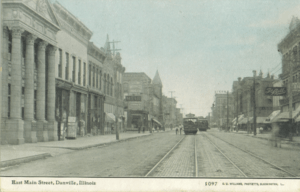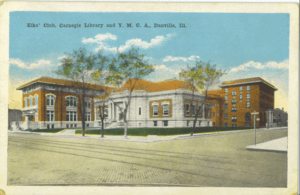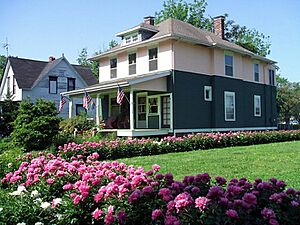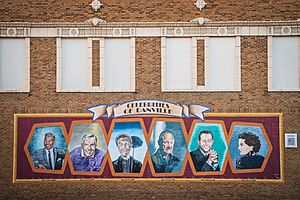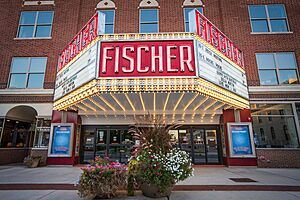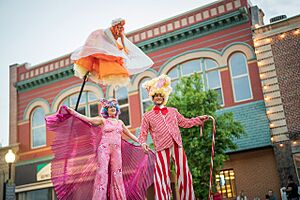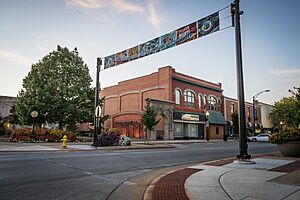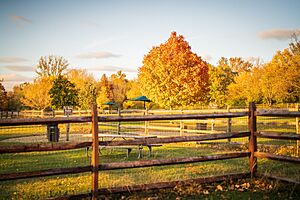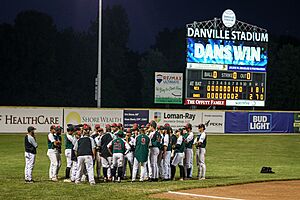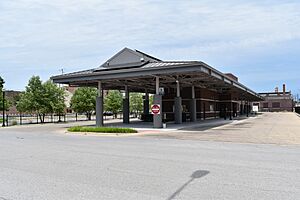Danville, Illinois facts for kids
Quick facts for kids
Danville, Illinois
|
||
|---|---|---|
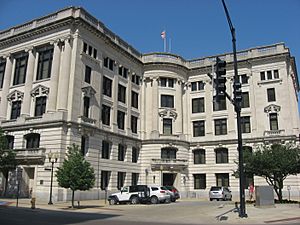
Vermilion County Courthouse
|
||
|
||
| Motto(s):
You Decide What's Possible.
|
||
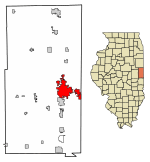
Location of Danville in Vermilion County, Illinois.
|
||
| Country | ||
| State | ||
| County | Vermilion | |
| Township | Blount, Danville, Newell | |
| Founded | April 10, 1827 | |
| Area | ||
| • City | 17.99 sq mi (46.59 km2) | |
| • Land | 17.86 sq mi (46.25 km2) | |
| • Water | 0.13 sq mi (0.34 km2) | |
| Elevation | 637 ft (194 m) | |
| Population
(2020)
|
||
| • City | 29,204 | |
| • Density | 1,635.53/sq mi (631.49/km2) | |
| • Metro | 81,625 | |
| ZIP code |
61832 and 61834
|
|
| Area codes | 217, 447 | |
| FIPS code | 17-18563 | |
| GNIS ID | 2393715 | |
| Website | CityOfDanville.org | |
Danville is a city in Illinois, United States. It is the main city of Vermilion County. In 2020, about 29,204 people lived there. Danville is also the biggest city in the Danville micropolitan area.
Contents
History of Danville
Long ago, the land where Danville now stands was home to Native American tribes. These included the Miami, Kickapoo, and Potawatomi people.
Danville was started in 1827. Two men, Guy W. Smith and Dan W. Beckwith, gave land for the city. It was named after Dan Beckwith. The first post office opened in May 1827.
In 1838, the Potawatomi Trail of Death passed through Danville. This was a sad time when many Potawatomi people were forced to move.
Famous American leader Abraham Lincoln visited Danville often. He worked as a lawyer in the area for about 18 years. He even gave a speech from the balcony of Dr. William Fithian's home. Today, the Fithian House is a museum.
In the late 1800s and early 1900s, Danville grew a lot. It became an important place for coal mining. Some of the first ways of digging coal from the surface were used here. Danville also became a big manufacturing center. The city's population doubled between 1900 and 1920. It was also a busy place for trains.
A special home for soldiers who were disabled, called the Danville Branch of the National Home for Disabled Volunteer Soldiers, opened in 1898. By 1910, over 4,000 veterans lived there. This place was like a small town itself, with its own train service, hospital, and even a theater.
In 1910, something exciting happened! Nine elephants escaped from a Ringling circus. They ran through Danville before being caught again.
Later, a college was started in Danville in 1946. It is now called Danville Area Community College. It uses some historic buildings from the old veterans' home.
After the mid-1900s, many mines and factories closed. This caused Danville's population to get smaller. However, many old mining areas were turned into beautiful lakes. These lakes are now great places for fishing and outdoor fun at parks like Kickapoo State Recreation Area. In recent years, Danville has worked to bring new businesses and improve its downtown area.
Geography of Danville
Danville is located in Illinois. It is about 120 miles (193 km) south of Chicago. It is also about 90 miles (145 km) west of Indianapolis, Indiana. Major roads like Illinois Route 1, U.S. Route 136, and U.S. Route 150 meet in Danville. Interstate 74 also goes through the southern part of the city.
Lake Vermilion is a large lake on the northwest side of Danville. The city covers about 18 square miles (46.6 sq km). Most of this area is land, with a small part being water.
Neighborhoods in Danville
Danville has many different neighborhoods. Some of them have groups that work to improve the area. The West Downtown neighborhood is one of the oldest parts of the city. People there work to keep its historic buildings safe.
The Lincoln Park neighborhood is another special area. It has a 22-acre park, also called Lincoln Park. This park is home to the Lamon House, a historic building.
Danville is generally split into three main parts:
- The downtown district is the old, historic center of the city.
- The retail district is where you find many stores and shops.
- The campus district includes the Danville Area Community College and the VA hospital.
Climate in Danville
| Weather chart for Danville, Illinois | |||||||||||||||||||||||||||||||||||||||||||||||
|---|---|---|---|---|---|---|---|---|---|---|---|---|---|---|---|---|---|---|---|---|---|---|---|---|---|---|---|---|---|---|---|---|---|---|---|---|---|---|---|---|---|---|---|---|---|---|---|
| J | F | M | A | M | J | J | A | S | O | N | D | ||||||||||||||||||||||||||||||||||||
|
2.1
34
17
|
2
40
22
|
3.2
52
32
|
3.9
65
41
|
4.5
75
51
|
4.7
84
60
|
4.4
86
64
|
3.9
84
63
|
3
78
55
|
3
67
43
|
3.5
52
34
|
2.8
39
23
|
||||||||||||||||||||||||||||||||||||
| temperatures in °F precipitation totals in inches source: The Weather Channel |
|||||||||||||||||||||||||||||||||||||||||||||||
|
Metric conversion
|
|||||||||||||||||||||||||||||||||||||||||||||||
The weather in Danville changes a lot throughout the year. In January, the average low temperature is about 17°F (-8°C). In July, the average high temperature is about 86°F (30°C).
The coldest temperature ever recorded was -26°F (-32°C) in January 1994. The hottest was 112°F (44°C) in July 1936. Danville gets the most rain in June.
| Climate data for Danville, Illinois (1991–2020 normals, extremes 1895–present) | |||||||||||||
|---|---|---|---|---|---|---|---|---|---|---|---|---|---|
| Month | Jan | Feb | Mar | Apr | May | Jun | Jul | Aug | Sep | Oct | Nov | Dec | Year |
| Record high °F (°C) | 70 (21) |
74 (23) |
84 (29) |
94 (34) |
103 (39) |
105 (41) |
112 (44) |
107 (42) |
102 (39) |
93 (34) |
82 (28) |
72 (22) |
112 (44) |
| Mean daily maximum °F (°C) | 35.3 (1.8) |
40.4 (4.7) |
52.0 (11.1) |
65.2 (18.4) |
75.3 (24.1) |
83.1 (28.4) |
85.4 (29.7) |
83.9 (28.8) |
78.9 (26.1) |
66.5 (19.2) |
51.9 (11.1) |
39.9 (4.4) |
63.1 (17.3) |
| Daily mean °F (°C) | 27.4 (−2.6) |
31.7 (−0.2) |
42.1 (5.6) |
53.7 (12.1) |
63.8 (17.7) |
72.2 (22.3) |
75.1 (23.9) |
73.5 (23.1) |
67.3 (19.6) |
55.4 (13.0) |
42.8 (6.0) |
32.4 (0.2) |
53.1 (11.7) |
| Mean daily minimum °F (°C) | 19.5 (−6.9) |
22.9 (−5.1) |
32.1 (0.1) |
42.3 (5.7) |
52.3 (11.3) |
61.3 (16.3) |
64.8 (18.2) |
63.0 (17.2) |
55.6 (13.1) |
44.3 (6.8) |
33.8 (1.0) |
24.9 (−3.9) |
43.1 (6.2) |
| Record low °F (°C) | −26 (−32) |
−22 (−30) |
−13 (−25) |
12 (−11) |
25 (−4) |
36 (2) |
41 (5) |
37 (3) |
22 (−6) |
13 (−11) |
−6 (−21) |
−25 (−32) |
−26 (−32) |
| Average precipitation inches (mm) | 2.47 (63) |
2.24 (57) |
3.23 (82) |
4.46 (113) |
4.63 (118) |
5.18 (132) |
4.34 (110) |
3.31 (84) |
3.26 (83) |
3.66 (93) |
3.70 (94) |
2.73 (69) |
43.21 (1,098) |
| Average precipitation days (≥ 0.01 in) | 10.6 | 8.9 | 11.1 | 12.1 | 13.1 | 11.6 | 10.2 | 8.6 | 8.5 | 9.9 | 10.3 | 10.8 | 125.7 |
| Source: NOAA | |||||||||||||
Economy in Danville
The main shopping area in Danville is the Village Mall, which opened in 1975. More stores and shops have opened north of town since the 1990s. Many new businesses have come to Danville since 2013, including Meijer and Kohl's Plaza.
Danville has special programs to help businesses grow. These include tax breaks and loans for small businesses. Groups like Vermilion Advantage also work to bring new jobs and development to the area.
Most jobs in Danville are in government, private companies, or non-profit organizations.
Arts and Culture in Danville
Danville has a lot to offer visitors. It is known for its connection to Abraham Lincoln. There are more than 12 places in Danville that remember his time practicing law there.
Other fun places to visit include the historic downtown area. Here you can find the Fischer Theatre. This theater has a museum about famous performers from Danville. These include Dick Van Dyke and Helen Morgan. The downtown area also has Temple Plaza, which is a place for performances. There are also 18 amazing murals painted by artists from all over the world.
Danville has many important buildings. Ten of them are on the National Register of Historic Places. These include a Carnegie library, which is now the Vermilion County War Museum. The Fithian Home, where Abraham Lincoln gave a speech, is also there.
Events and Festivals
Danville hosts many fun events throughout the year. The city organizes "First Fridays in Downtown Danville." These are monthly events that are often free for everyone to enjoy.
In July, people come from all around for "Balloons Over Vermilion." This event features colorful hot air balloons. In June, artists gather for the "Arts in the Park" event in Lincoln Park. During the summer, Temple Plaza hosts the "Summer Sounds Concert Series." In the fall, the city has the "Vermilion River Fall Festival." There are also parades, farmers' markets, and sports events.
Cultural Institutions
Danville has several cultural places and museums. If you like art, there is the Danville Art League and the Danville Symphony Orchestra. For theater, you can find the Danville Light Opera and the Red Mask Players.
Places to see performances include the historic Fischer Theatre and the Kathryn Randolph Theater. Museums in the city include the Vermilion County Museum and the Vermilion County War Museum.
Parks and Recreation in Danville
Danville has more than 20 parks and recreation spots. These range from small neighborhood parks to large areas. When combined with county and state parks nearby, there are over 15,000 acres of public parkland. This means Danville has more park space per person than almost any other county in Illinois!
Danville is next to Lake Vermilion. This is a 1,000-acre lake where you can go fishing, watch birds, and enjoy boating. The Vermilion River also flows through the area. It offers more chances for outdoor fun and is home to lots of wildlife.
Some notable parks in the city include Lincoln Park. It has old trees, tennis courts, and the Lamon House. On the west side, the North Fork of the Vermilion River goes through Harrison Park Golf Course. This 235-acre course is great for golf and hiking.
On the north side, Heron County Park has a long boardwalk that goes into Lake Vermilion. From its observation tower, you can often see bald eagles and American egrets. Ellsworth Park on the west side has disc golf and walking paths.
Downtown Danville has smaller parks like Lindley Sign Forest and Temple Plaza. Temple Plaza is a popular spot for community events.
Other fun things to do include visiting Fetch Dog Park. You can also watch the Danville Dans baseball team play. The Garfield Park Aquatic Center offers swimming, and there are many local sports leagues.
Demographics of Danville
| Historical population | |||
|---|---|---|---|
| Census | Pop. | %± | |
| 1840 | 503 | — | |
| 1850 | 736 | 46.3% | |
| 1860 | 1,632 | 121.7% | |
| 1870 | 4,751 | 191.1% | |
| 1880 | 7,733 | 62.8% | |
| 1890 | 11,491 | 48.6% | |
| 1900 | 16,354 | 42.3% | |
| 1910 | 27,871 | 70.4% | |
| 1920 | 33,776 | 21.2% | |
| 1930 | 36,765 | 8.8% | |
| 1940 | 36,919 | 0.4% | |
| 1950 | 37,864 | 2.6% | |
| 1960 | 41,856 | 10.5% | |
| 1970 | 42,570 | 1.7% | |
| 1980 | 38,985 | −8.4% | |
| 1990 | 33,828 | −13.2% | |
| 2000 | 33,904 | 0.2% | |
| 2010 | 33,027 | −2.6% | |
| 2020 | 29,204 | −11.6% | |
| U.S. Decennial Census | |||
Danville is the main city of the Danville Micropolitan Statistical Area. This area includes all of Danville and Vermilion County.
In 2020, there were 29,204 people living in Danville. About 57% of the people were White, and 34.6% were African American. About 7.6% of the population was Hispanic or Latino.
About 24.4% of the people were under 18 years old. About 18.5% were 65 years or older. The average household had 2.27 people. The average family had 3.25 people.
The median income for a household in Danville was $44,239. For families, it was $59,930.
2022 American Community Survey 5-year estimates
|
Racial Makeup of Danville (2022) White alone (58.60%) Black alone (33.08%) Native American alone (0.08%) Asian alone (1.33%) Pacific Islander alone (0.03%) Other race alone (1.73%) Multiracial (5.15%) |
Racial Makeup of Danville excluding Hispanics from Racial Categories (2022) |
Racial Makeup of Hispanics in Danville (2022) White alone (35.67%) Black alone (0.56%) Native American alone (0.00%) Asian alone (0.00%) Pacific Islander alone (0.00%) Other race alone (21.59%) Multiracial (42.19%) |
Sports in Danville
Danville is home to the Danville Dans. This is a summer baseball team that plays at Danville Stadium. They were started in 1989. The team has won nine championships in their league.
Danville also had a hockey team called the Danville Dashers. They played from 2011 to 2020. Later, a new hockey team, the Vermilion County Bobcats, played there for a short time.
Education in Danville
Colleges
- Danville Area Community College
- Lakeview College of Nursing
Primary and secondary education
- High schools
- Danville High School
- Schlarman Academy
- First Baptist Christian School
- Danville Christian Academy
- Danville New Tech High
- Kenneth D. Bailey Academy
- Middle schools
- Danville Lutheran School
- Schlarman Academy
- North Ridge Middle School
- First Baptist Christian School
- Elementary schools
- Schlarman Academy
- Danville Lutheran School
- First Baptist Christian School
- Edison
- Garfield
- Liberty
- Mark Denman (formerly known as East Park)
- Meade Park
- Northeast
- South View Upper Elementary (5th and 6th Grade, formerly known as South View Middle School)
- Southwest
Transportation in Danville
For air travel, there is the Vermilion Regional Airport.
Danville is a big hub for trains. Many different train tracks meet in the town. This means there are many railroad crossings. Major railway companies like CSX Transportation and Norfolk Southern Railway have lines that go through Danville.
Danville Mass Transit (DMT) runs 14 bus routes. These buses serve Danville and the areas around it.
Notable people from Danville
See also
 In Spanish: Danville (Illinois) para niños
In Spanish: Danville (Illinois) para niños


